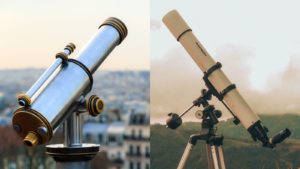Telescope vs Spotting Scope

Telescopes are designed to view celestial bodies and spotting scopes are typically used for viewing wildlife. While they may look and sound similar, they have distinct differences in usage, view and portability.
How Are Telescopes and Spotting Scopes Used?
Telescopes are used to observe objects in space while spotting scopes are used to view objects on earth. Because telescopes magnify the light from celestial bodies, you’ll get the most detailed view when it’s dark outside. Spotting scopes are designed to work best during the day because they are used for outdoor activities. These include animal watching, hunting, surveillance and photography.
Which Lenses Do Telescopes and Spotting Scopes Use?
Spotting scopes come with objective lenses, ranging from 45mm to 100mm. This means they have a clearer view of close distances, but won’t be very helpful when stargazing. Telescopes have larger apertures and lenses, which can range anywhere from 60mm to above 400mm. This makes telescopes more suitable for astronomy.
Which Are More Durable, Telescopes or Spotting Scopes?
Because spotting scopes are designed for hunting and wildlife watching, they are typically much more durable. This can include protection against weather, impact and other obstructions. Telescopes are much larger and more fragile because they aren’t designed to be moved frequently.
Telescopes vs Spotting Scopes. Which is Easier to Use?
Telescopes take longer to set up because they require you to align the scope and configure the lens. This can take anywhere from a few minutes to an hour, depending on the telescope and observation. To use a spotting scope, you just need to locate and zoom in on an object.
